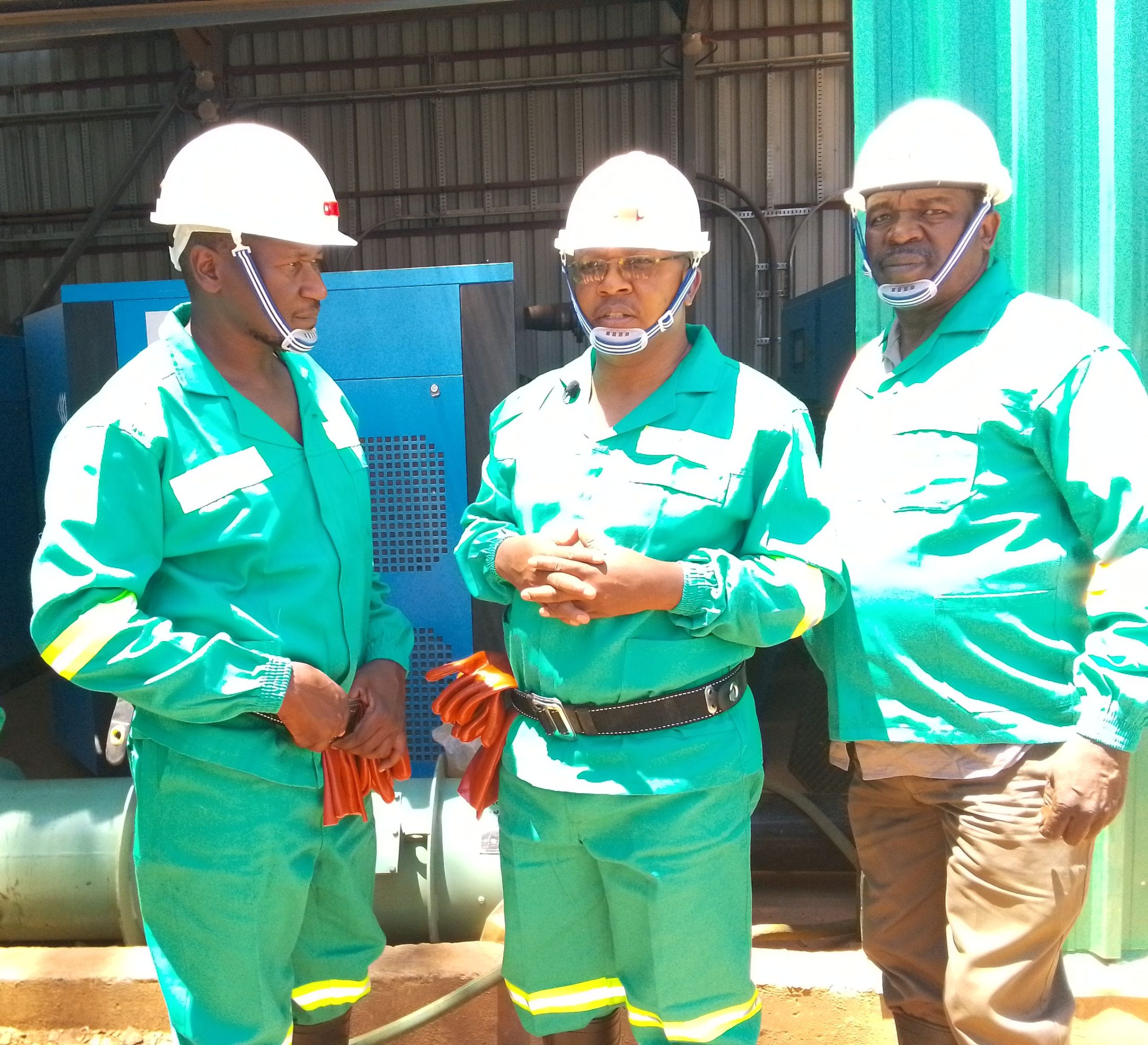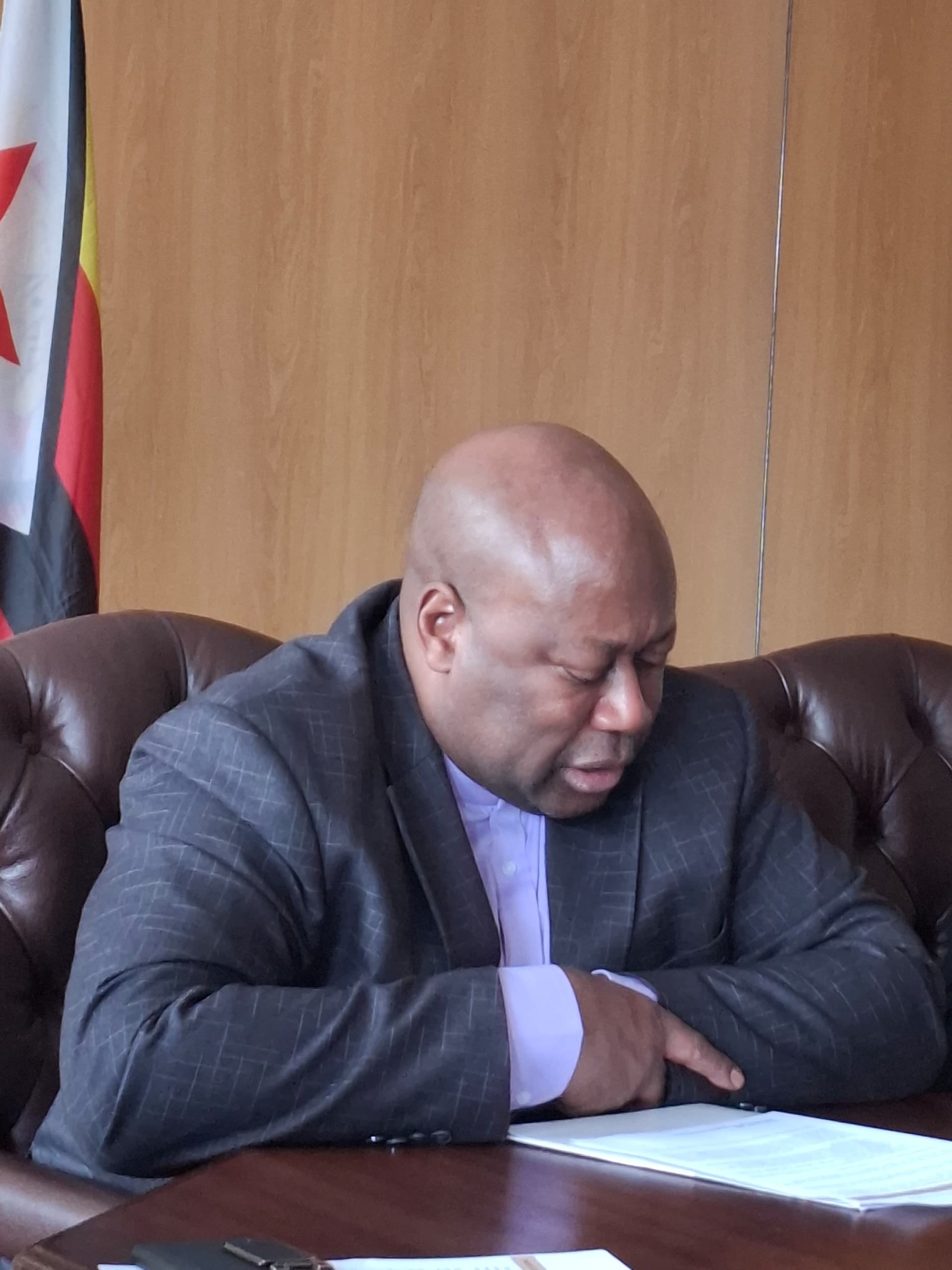Three Engineers In One Picture: Deputy Minister of Mines and Mining Development Honourable Dr Eng Polite Kambamura (centre) is flanked by Engineer Madowe (left) and Engineer Munodawafa (right) just before getting into the underground section of Pickstone Peerless Mine, in Chegutu, Mashonaland West.
By Dickson Bandera
A mining agreement known as “The Rudd Concession” signed between Charles Rudd and King Lobengula in 1888 is a well known piece of Zimbabwean history, popular with history scholars and Zimbabweans in general.
It is regarded as the foundation upon which Zimbabwe was colonised. For many years, the history has been taught in schools at different levels and much has been written or spoken about it in the mass media and textbooks.
History has it that on 30 October 1888, Charles Dunnell Rudd together with Rochfort Maguire and Francis Thompson arrived in the land now present day Zimbabwe where he entered into a mining agreement on behalf of Cecil John Rhodes with the Matebeland king, Lobengula Khumalo for exclusive “mining rights in Matebeleland, Mashonaland and other adjoining territories”.
Rhodes, an ambitious British politician and businessman who had settled in South Africa and was involved in gold mining there, formulated the Rudd Concession idea. He sent his represantives to the Matebeland king, to negotiate for an agreement which would feed into his expansion drive.
At that time, the Berlin Conference (1884) in which European countries convened and partitioned Africa for colonisation, had just concluded and there was a rush to occupy African territories by Europeans.
Rhodes, who was already into mining in neighboring South Africa, saw the inroads into the northern territory as strategic, and Lobengula’s signature was all that he needed to get the blessings from the British authorities to colonise a new territory.
In 1889, the Royal Charter was granted by the British Queen and Rhodes assembled a team, the Pioneer Column that would come and operationalize the charter. His offensive was successful hence the Pioneer Column entered the territory via Fort Tuli, then Fort Victoria (Masvingo), Charter (Chivhu) and finally Salisbury (Harare). On 12 September 1890, the Union Jack, an emblem for the British authority was hoisted in Salisbury, marking the official colonisation of the country.
Interestingly, one of the mines that were given to Charles Rudd under the Rudd Concession is the present day Pickstone Peerless Mine, situated in Chegutu, Mashonaland West province, some 120km south-west of Harare.
Unlike mining during the colonial era where locals were just providers of cheap or free labour, and working under inhumane conditions, mining in the independent Zimbabwe is designed to benefit Zimbabweans, while it is open to partner with any foreign company on a win-win basis.
The mining industry is now guided by a vibrant policy and legal framework predicated on standard business and labour practices.
Pickstone Peerless Mine, is owned by Dallaglio, a mining unit of Padenga Holdings Pvt Ltd which has interests in other sectors like the food industry. Dallaglio who is confident of great expansion in the coming years, also operates Eureka Mine in Guruve, all these business units created with due regards to the empowerment of Zimbabwean citizens in line with the government policy.
As at 30 June 2020, Pickstone’s underlying claims had a total measured and indicated resource of 368,313 ounces (11,456 kg), and a total resource (including inferred) of 789,424 ounces (24,553 kg). Production levels are expected to reach 250kgs per month by 2025.
For the past 135 years, this mine has shifted from one owner to another, with the current owners, Dallaglio Pvt Ltd coming in 2014. Previous owners include African Banking Cooperation, Lonhro, RTZ, Masasa, Weston and Mutapa.
Successive leadership at the gold mine has kept records of the mine including maps outlining the mining activities that have taken place along the time. The maps, now mordenized into 3 dimensional formats are used by the engineers in determining mining activities and in drawing safety and productivity mechanisms.
After operating as an open pit mine from 2015, Pickstone Mine is now switching into underground mining. The decision to start mining underground was taken as it had become uneconomical to continue open cast mining at the site.
Deputy Minister of Mines and Mining Development Honourable Dr Eng Kambamura this Thursday visited the mine to assess the progress of the underground mining expansion project as well as the general status of the mine.
Mine General Manager, Engineer Alfred Madowe and his vibrant leadership, who demonstrated top notch knowledge of the processes currently being undertaken at Pickstone Peerless Mine, took the Deputy Minister through the Mine operations and the switch over to underground mining.
Engineer Madowe said the expansion project has so far injected US$22 million under phase 1, and phase 2 will see injection of US$27 million.
“The first 22 million was injected into the operation to get the underground operation started at 5 Level. This basically meant equipping the shaft, that is, the headgear, the shaft to 5 Level, putting a loading level to Level 5, putting a hoist on surface, putting a conveyer, surface bins, including all the infrastructure for the other shafts which is for milling material, basically the hoist, runners and so forth. These have all been purchased, we have just deferred the construction to Phase 2,” said Engineer Madowe.
He added that: “Phase 2 is going to include the equipping of the milling material shaft which has already started and extend the rock shaft to the next loading level which is going to be 7 Level. This is another 150m further down, under Phase 2A. Phase 2B will take us to 10 level and 2C to level 12 level. Those 4 phases are going to cost us 27m”.
Asked on the extent of exploration for the underground mining, Engineer Madowe said the mine carried a successful conceptual study and was now engaged in the feasibility study with indications so far showing a large ore body.
“What we started by doing is a conceptual study, which took the exploration drilling that we did for the surface operations. It extended for about 60m-100m below the pit bottom, so we used that information and did some extrapolation to estimate the shape and size of the ore body further down.
“The indications are that we have the potential underground operation. It’s a bigger body slightly lower grade than Pickstone but because of the volumes, it is able to sustain a good viable underground operation.We did the conceptual study and we are now on a feasibility study.
“What we want to do is to put a decline and then go about 40m below the pit and start drilling further down to do exploration and in the basis of that exploration we can then define the size and type of the underground resource,” explained Engineer Madowe.
The mine leadership also outlined the Safety and Health mechanisms, Corporate Social Responsibility programmes in place as well as the future plans of the mine.
In his presentation, the Mine SHE officer said the mine had put in place mechanisms to ensure that accidents do not occur, and that the environment and the people remain protected. He said the mine was was minimising the risks with regards to exposure to chemicals, air pollution, production of dust, land degradation, deforestation and loss of biodiversity, among other risks.
In the new underground section, plants, water controls, railways, ventilation, fixed lighting are now in place. Lighting has been installed along travel ways and at shaft stations, dumping points, and other important locations. Each underground miner is also equipped with a hard-hat-mounted lamp with the battery worn on the belt to add light at the various work areas.
With regards to employment creation, the mine has employed about 500 locals and looks forward to increase the numbers with the ongoing investments. A full complement of supporting infrastructure includes staff housing, office, stores, grid power, boreholes, and road infrastructure.
Cordillera, a community share ownership arrangement in which the mine allocated claims to the community members so that they sustain themselves, was established to controll illegal mining and now stand as a corporate social responsibility program which is giving the locals a source of livelihood.
The mine has also drilled boreholes, and is assisting with provision of material resources at the local schools and clinic.
Honourable Kambamura was impressed with the progress at the mine and urged the leadership to bear in mind that the mining industry has occupied an important role in raising revenue that will support the national development goals.
“It is important to note that this operation here is high grade low volume as opposed to Eureka Mine which is low grade high volume.
“You should continue to mine sustainably to ensure future generations also benefit from the resource,” he said.
He added, “Vision 2030 is build up by contributions from different sectors of the economy. So in this sector its all about opening new mines. How do we open new mines? Through intensive exploration, reopening of closed mines, these were the pillars of the Transitional Stabilisation Programme. And all that has been done.
“So what Pickstone Peerless Mines has done is reopening of the closed mine. They closed long back because they were focussing on high grades but those grades are now low grades, the cut off grades have changed because of the economic environment that is now conducive for business,” said the Hon mining Engineer.
The progress at Pickstone Peerless Mine also dovetails with another guiding principle, the Heritage Based Economy 5:0 which seeks to derive optimum value from the country’s natural resources on the development agenda.


